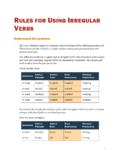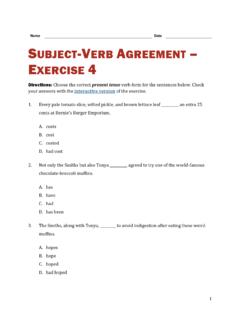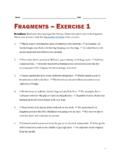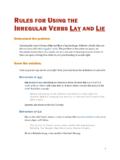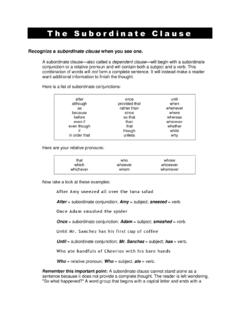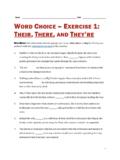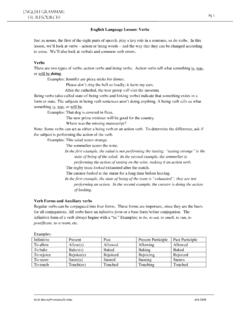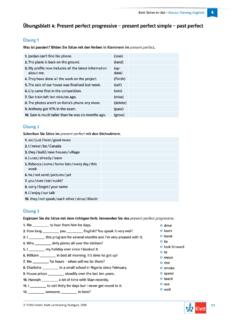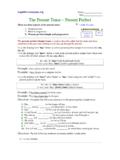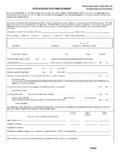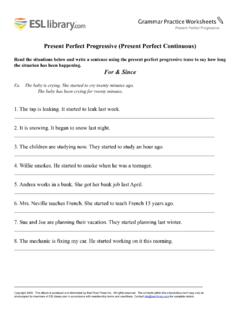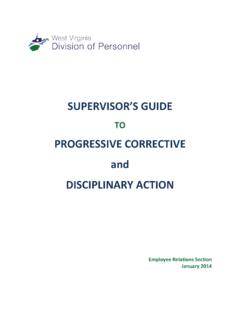Transcription of The Auxiliary Verb
1 1 THE Auxiliary verb Recognize an Auxiliary verb when you see one. Every sentence must have a verb . To depict doable activities, writers use action verbs. To describe conditions, writers choose linking verbs. Sometimes an action or condition occurs just once bang! and it's over. N a t e s t u b b e d h i s t o e . He is m i s e r a b l e w i t h p a i n . Other times, the activity or condition continues over a long stretch of time, happens predictably, or occurs in relationship to other events. In these instances, a single-word verb like stubbed or is cannot accurately describe what happened, so writers use multipart verb phrases to communicate what they mean.
2 As many as four words can comprise a verb phrase. A main or base verb indicates the type of action or condition, and Auxiliary or helping verbs convey the other nuances that writers want to express. Read these three examples: S h e r y l e e s m a c k e d h e r l i p s a s r a s p b e r r y j e l l y d r i p p e d f r o m t h e d o n u t o n t o h e r w h i t e s h i r t . S h e r y l e e is a l w a y s d r i p p i n g s o m e th i n g . S i n c e S h e r y l e e i s s u c h a k l u t z , s h e s h o u l d h a v e b e e n e a t i n g a c a k e d o n u t , w h i c h w o u l d n o t h a v e s t a i n e d h e r s h i r t.
3 In the first sentence, smacked and dripped, single-word verbs, describe the quick actions of both Sherylee and the raspberry jelly. Since Sherylee has a pattern of messiness, is dripping communicates the frequency of her clumsiness. The Auxiliary verbs that comprise should have been eating and would have stained express not only time relationships but also criticism of Sherylee's actions. 2 Below are the Auxiliary verbs. You can conjugate be, do, and have; the modal auxiliaries, however, never change form. BE DO HAVE am is are was were being been does do did has have had having MO D A L AU X I L I A R I E S [NE V E R CH A N G E FO R M] can, could, may, might, must, ought to, shall, should, will, would Understand the dual nature of be, do, and have.
4 Be, do, and have are both stand-alone verbs and Auxiliary verbs. When these verbs are Auxiliary , you will find them teamed with other verbs to complete the verb phrase. Compare these sentences: F r e d d y is envious of Beatrice s steaming bowl of squid eyeball stew. Is = linking verb . F r e d d y i s st u d y i n g Beatrice s steaming bowl of squid eyeball stew w i t h e n v y i n h i s e y e s . 3 Is = Auxiliary verb ; studying = present participle completing the verb phrase. We d i d o u r h o m e w o r k f o r M r s.
5 L o n g . Did = action verb . We re not slackers! We d i d p r e p a r e o u r h o m e w o r k f o r M r s . L o n g . Did = Auxiliary verb ; prepare = main verb completing the verb phrase. S e l e n a h a s t w e l v e o r a n g e g o l d f i s h i n h e r a q u a r i u m . Has = action verb . S e l e n a h a s b o u g h t a c a t f i s h t o h e l p k e e p t h e t a n k c l e a n . Has = Auxiliary verb ; bought = past participle completing the verb phrase. Form progressive tenses with the Auxiliary verb be.
6 All progressive tenses use a form of be. FO R M S O F BE am, is, are, was, were, being, been PR E S E N T PR O G R E S S I V E present progressive follows this pattern: AM, IS, OR ARE + PR E S E N T PA R T I C I P L E Use the present progressive tense to convey an action or condition happening right now or frequently. I a m b a k i n g c h oc o l a t e-b r o c c o l i m u f f i n s t o d a y . Am = Auxiliary verb ; baking = present participle completing the verb phrase. A l e x i s s i t t i n g a t t h e k i t c h e n t a b l e , a n t i c i p a t i n g h i s f i r s t b i t e.
7 4 Is = Auxiliary verb ; sitting = present participle completing the verb phrase. A l e x m u s t w a i t a w h i l e l o n g e r b e c a u s e t h e m u f f i n s a r e c o o l i n g b y t h e w i n d o w . Are = Auxiliary verb ; cooling = present participle completing the verb phrase. I m p a t i e n t A l e x is a l w a y s w a i t i n g t o t a s t e w h a t e v e r I c o o k . Is = Auxiliary verb ; waiting = present participle completing the verb phrase. PA S T PR O G R E S S I V E past progressive follows this pattern: WAS OR WERE + PR E S E N T PA R T I C I P L E Use the past progressive tense to show either 1) an action or condition that continued in the past or 2) an action or condition interrupted by another.
8 N a o m i w a s h o p i n g f o r a n A i n h e r o r g a n i c c h e m i s t r y c l a s s . Was = Auxiliary verb ; hoping = present participle completing the verb phrase. U n f o r t u n a t e l y , N a o m i ' s l a b r e p o r t s w e r e m i s s i n g t h e n u t r i t i o n a l d a t a o n c h o c o l a t e-b r o c c o l i m u f f i n s . Were = Auxiliary verb ; missing = present participle completing the verb phrase. W h i l e N a o m i w a s o b s e s s i n g a b o u t h e r g r a d e , J a s o n s h a r e d t h e d a t a t h a t s h e n e e d e d.
9 Was = Auxiliary verb ; obsessing = present participle completing the verb phrase. FU T U R E PR O G R E S S I V E Future progressive looks like this: 5 WI L L + BE + PR E S E N T PA R T I C I P L E Use the future progressive tense to indicate an action that will continue in the future. I w i l l b e g r o w i n g b r o c c o l i i n t h e b a c k y a r d t h i s s p r i n g . Will, be = Auxiliary verbs; growing = present participle completing the verb phrase. S o o n , A l e x w i l l b e e a t i n g o r g a n i c c h o c o l a t e-b r o c c o l i m u f f i n s !
10 Will, be = Auxiliary verbs; eating = present participle completing the verb phrase. Form passive voice with the Auxiliary verb be. You can make any transitive verb an action verb that can take a direct object passive with the Auxiliary verb be. Active voice looks like this: SU B J E C T + verb + DI R E C T OB J E C T Here are some samples: We l i c k e d o u r l i p s . F r a n k d e v o u r e d a b a c o n d o u b l e c h e e s e b u r g e r . E v e r y o n e e n v i e d h i s e n j o y m e n t . Passive voice makes these changes: DI R E C T OB J E C T AS SU B J E C T + FORM OF BE + PA S T PA R T I C I P L E + BY + SU B J E C T AS OB J E C T OF T H E PR E P O S I T I O N Now read these revisions: O u r l i p s w e r e l i c k e d by us.
